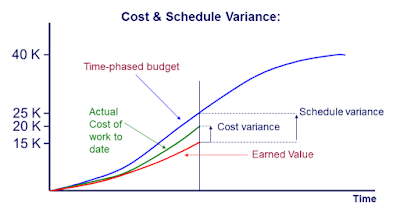Government contract management demands meticulous oversight and effective control to ensure successful project execution within budgetary constraints. One important tool for achieving this is Earned Value Management (EVM). EVM is a systematic project management approach that integrates cost, schedule, and scope to provide a holistic view of project performance. In the context of government contracts, where transparency, accountability, and compliance are paramount, EVM is an essential tool to ensure adherence to contractual obligations.
Ok, great, but what is EVM? It is a project management technique that helps project managers measure project performance in an integrated manner. It involves the use of key performance indicators (KPIs) to assess the progress of a project based on the scope of work completed, the time taken, and the costs incurred. The three primary components of EVM are:
- Planned Value (PV): The authorized budget assigned to the work planned to be accomplished by a specific time.
- Earned Value (EV): The value of the work actually performed, expressed in terms of the approved budget assigned to that work.
- Actual Cost (AC): The costs actually incurred for the work performed.
To implement EVM, project managers use several key formulas that help quantify project performance:
Cost Performance Index (CPI): CPI = EV / AC
• A CPI greater than 1 indicates that the project is performing under budget.
• A CPI less than 1 suggests that the project is over budget.
Schedule Performance Index (SPI): SPI = EV / PV
• An SPI greater than 1 indicates that the project is ahead of schedule.
• An SPI less than 1 suggests that the project is behind schedule.
Variance at Completion (VAC): VAC = BAC - EAC
• VAC represents the estimated cost variance at the end of the project.
Picture a government agency embarking on a complex project, a venture laden with responsibilities and taxpayer dollars. Enter Earned Value Management (EVM), a guiding light in the realm of project transparency. EVM isn't just a set of calculations; it's a standardized and transparent approach to project reporting. Imagine the veil being lifted as government agencies gain a bird's-eye view of project performance through key metrics. This newfound clarity fosters accountability, ensuring that contractors toe the line of agreed-upon terms.
Juggling multiple phases and tasks, timing is everything in project execution. EVM acts as a vigilant watchman, enabling project managers to identify discrepancies in the early beats of the project lifecycle. As planned, earned, and actual values intertwine, anomalies are illuminated. This isn't merely about numbers; it's about timely intervention, a preemptive strike against issues before they crescendo into the ominous symphony of project failure.
Numbers, when crunched correctly, tell a story – one of financial health and resource efficiency. EVM takes the helm in crafting this narrative. Through the lens of the cost performance index, EVM enables precise forecasting of project costs. Imagine government agencies equipped with a financial compass, navigating the budgetary seas with confidence. In this narrative, decisions are driven not by guesswork but by a data-driven understanding of the project's fiscal landscape.
Government contracts, like a script, come with stringent requirements and regulations. Enter EVM, the script supervisor of project compliance. It doesn't just ensure adherence; it provides a structured methodology for compliance monitoring. Auditors, in their quest for project integrity, find EVM to be a reliable ally, simplifying the assessment of whether projects are executing in harmony with regulatory standards.
So, envision a room filled with government stakeholders — each armed with real-time data on cost and schedule performance. While not a literally crystal ball, decision makers can make better choices with the help of EVM. The narrative shifts from reactive to proactive, encompassing adjustments to scope, reallocation of resources, and the implementation of risk mitigation strategies.
At the heart of EVM is accuracy, which is dependent on precise data inputs. And accuracy relies on repeatable processes; adequate training becomes the guide, transforming project managers so they are capable of maximizing the benefits of EVM. This tool complements and enhances other project management systems, increasing the likelihood of project success.

No comments:
Post a Comment